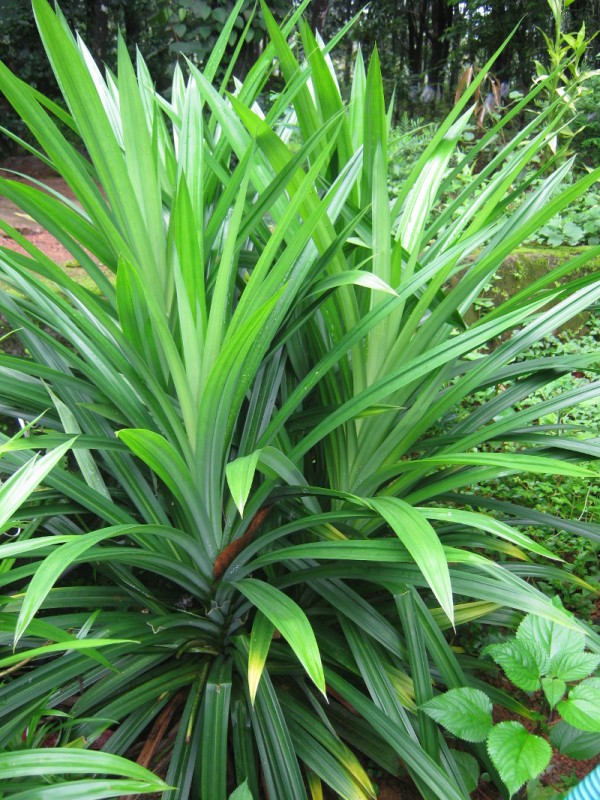Pandanus amaryllifolius Roxb. - Pandanaceae - syn.Pandanus latifolius Hasskarl (1842), not Perrot (1825); P. odorus Ridl.
pandan, edible pandanus
Evergreen herb with aerial roots and branched stem, cultivated in Indonesia (West Papua), Malaysia, Philippines, Sri Lanka, Thailand, China and Vietnam. „leaf apex with 2 distinct lateral pleats and dense antrorse spines (prickles) ca. 1 mm along pleats…; female inflorescence unknown; male inflorescence (evidently exceedingly rare) probably pendent, to 60 cm“ http://www.efloras.org/florataxon.aspx?flora_id=2&taxon_id=242335482
The sword-shaped leaves own a pleasant slightly vanilla-nutty odor, fresh or dried. They are used in many cuisines of Southeast Asia as a condiment. The fresh leaves (indonesian Daun Pandan, thai bai tooey, ใบ เตย) are either cooked with the food or the food is wrapped in leaves and steamed within or fried; in all cases the leaves serve only for adding flavor and are not consumed. Pandan leaves are frequently used in the preparation of less high-quality rice varieties, to improve their taste. https://de.wikipedia.org/wiki/Pandanus_amaryllifolius
Fresh leaves of P.amaryllifolius contained 2-acetyl-1-pyrroline (characteristic odor of white bread crust or basmati rice) at 10.3 mg/kg.
[Identification and Quantitation of the Rice Aroma Compound, 2-Acetyl-1-pyrroline, in Bread Flowers (Vallaris glabra Ktze). Sugunya Wongpornchai, Tinakorn Sriseadka, Suppachai Choonvisase, J. Agric. Food Chem., 51 (2), 2003, 457–462]
Volatile compounds of a dichloromethan extract of the leaves included 3-methyl-2-(5H)-furanone (70%) as the main component, as well as 3-hexanol, 4-methyl-2-pentanol, 3-hexanone, ranging from 2-7% of the total volatiles, so the pandan extract had also fresh and green notes. [Volatile Composition of Pandan Leaves (Pandanus Amaryllifolius). J. Jiang, Flavor Chemistry of Ethnic Foods, 1999, 105-109]
The dried leaves contain alkaloids of the pyrrolidine type, like Pandanamilactonines (A,B,C,D) and two others, as well as (6E- and 6Z-)pandanamine.
[New Alkaloids from Pandanus amaryllifolius. Salim, Angela A., Mary J. Garson, and David J. Craik. Journal of natural products, Vol.67(1), 2004, 54-57] http://herbs.ph/attachments/article/1710/New%20Alkaloids%20from%20Pandanus%20amaryllifolius.pdf
„Pandanus amaryllifolius, an herb, is cultivated in home gardens in coastal regions of India. The leaves are added to ordinary rice while cooking to impart basmati rice aroma. The plant bears the same aroma principle 2-acetyl-1-pyrroline (2AP) that has been reported in Basmati and other scented rice. Quantitatively the 2AP contents are highest in this plant among the plant kingdom. Therefore, it has good scope for commercial cultivation.“
[Pandanus amaryllifolius Roxb. cultivated as a spice in coastal regions of India., Wakte, K.V., Nadaf, A.B., Thengane, R.J., Jawali, N., Genetic resources and crop evolution, 56(5), 2009, 735-740]
„… 2AP, hexenal and nonanal were found to be major compounds present in elevated amounts than scented rice. 2AP (popcorn-like, pleasant odour) accounted for 8.52% of total volatiles besides hexanal (green tomato, grassy odour, 6.63%), 2-hexenal (green, apple, grassy odour, 21.87%), nonanal (floral, soapy, citrus-like odour, 10.50%), 2,6-nonadienal (cucumber-like odour, 3.11%), 3-methyl-2(5H)-furanone (caramel, sweet honey odour, 3.12%) and phytol (5.28%) being major components. Adding the raw leaves of P. amaryllifolius in ordinary rice to impart basmati aroma has remained as an old practise in south-east Asian countries.“
[Optimization of HS-SPME conditions for quantification of 2-acetyl-1-pyrroline and study of other volatiles in Pandanus amaryllifolius Roxb., Wakte, K.V., Thengane, R.J., Jawali, N., Nadaf, A.B., Food chemistry, 121(2), 595-600]

Pandan plant in Kerala, India
CC BY-SA 3.0, Author: Zuhairali Wikimedia Commons

